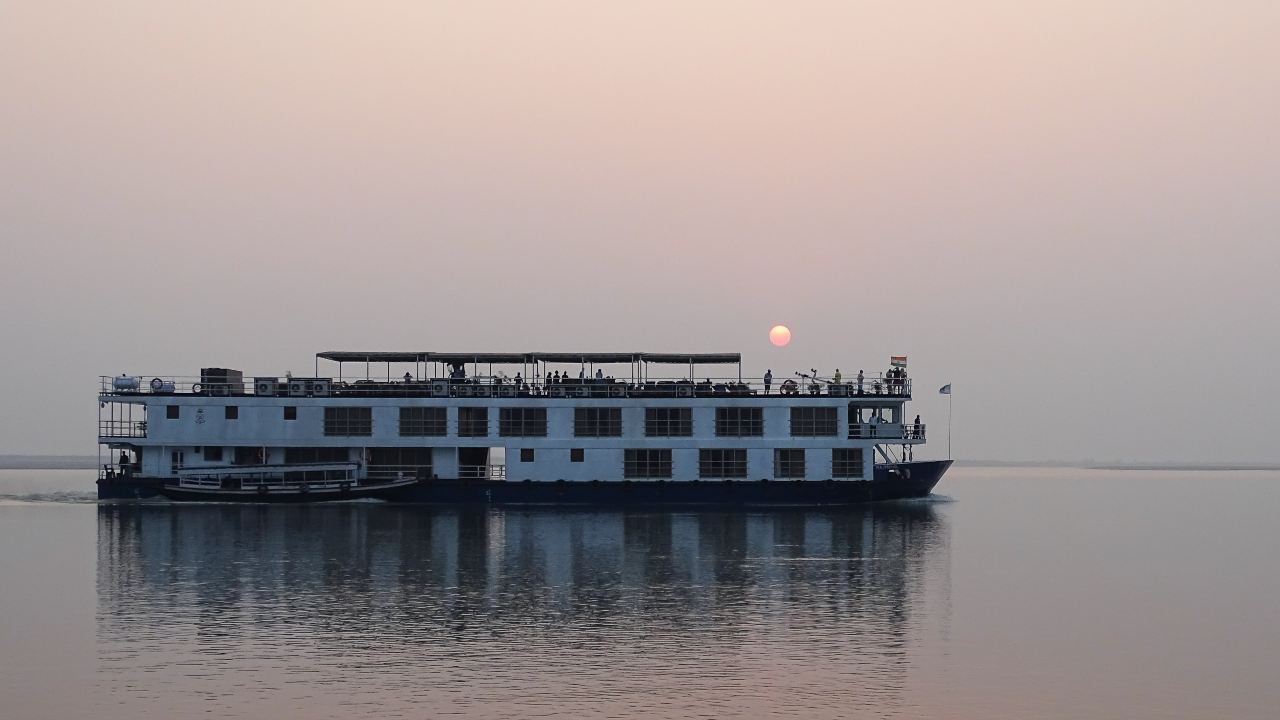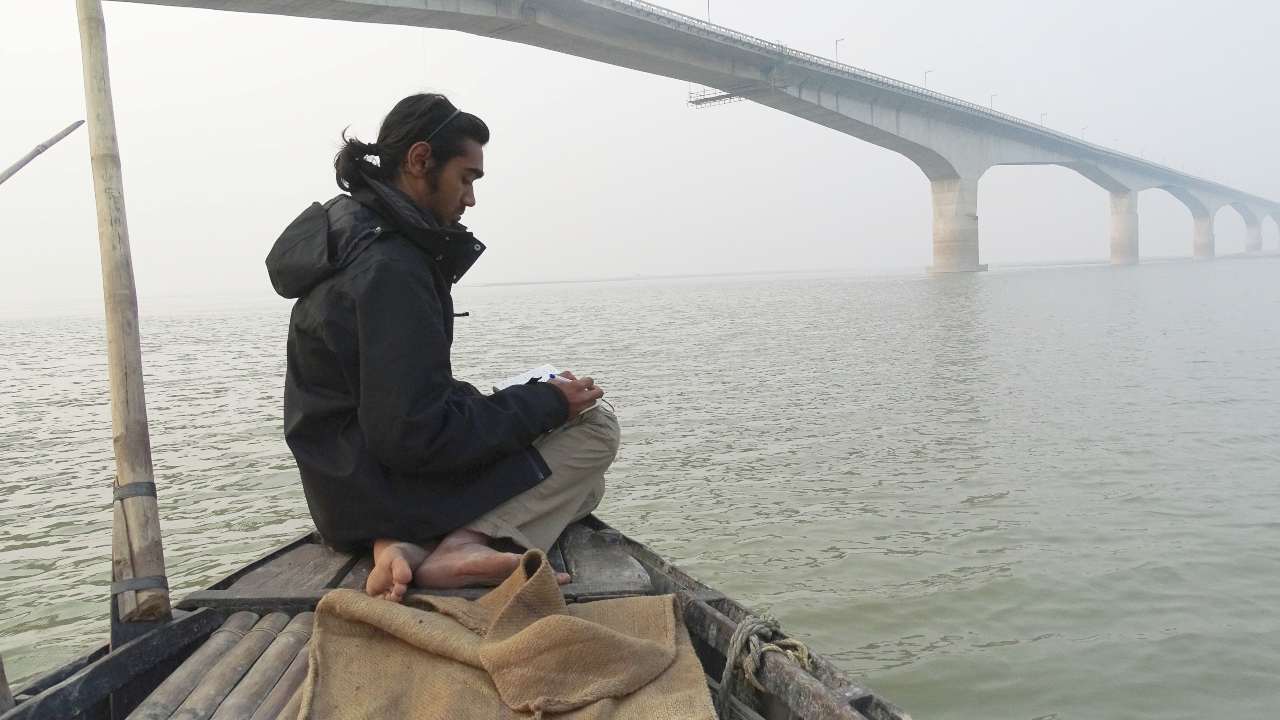In aquatic environments, like the inland rivers in India, the waters are muddy. The visibility is poorer in these parts from more clearer blue oceanic waters. Many of the animals living in these waterways rely far more on sound than sight for their survival. The noise made by aeroplanes, ships and cars are examples of human-made noise on air, water and land. Underwater noise that comes from the navigation systems of river vessels, called sonar and their propellers interferes with the vocalization of aquatic animals for foraging for food and detecting their immediate environment. This, according to a team of researchers at National Centre for Biological Sciences (NCBS), Ashoka Trust for Research in Ecology and the Environment (ATREE) and Mie University in Japan, is a glimpse of the situation unfolding in river Ganga. In a study, they looked at the impact of noise pollution from river vessels has on the Ganges river dolphins and published their findings in the journal Nature Scientific Reports. [caption id=“attachment_7706051” align=“alignnone” width=“1280”] A Ganges River Dolphin on the prowl. Image credit: Subhasis Dey[/caption] Increase in underwater noise levels due to more number of river vessels plying on the Ganga, for both cargo and leisure purposes, is having an adverse impact on the river dolphin, according to the findings of the study. “When there are very few vessels passing by in an area the noise is intermittent, that is the time when dolphins call for longer durations or call louder, to compensate for the intermittent increase noise,” explains Mayukh Dey, a student of the postgraduate wildlife course, at the time of the study, at NCBS and who carried out the research. On the other hand, when there were more boats passing by in a section of the river, the dolphins didn’t vocalise a great deal. This makes sense, considering noises from boats are rarely consistent enough as they pass by, one boat after another. “You can imagine if you’ve to keep shouting all the time that (it) can be quite tiring to you,” says Dey. [caption id=“attachment_7706041” align=“alignnone” width=“1280”]
 A tourist vessel, one of the many sources of noise pollution on the Ganges that is known to interfere with the communication of river dolphins below. Image: Author Provided[/caption] Due to such modifications in their acoustic behaviour, dolphins also probably incurred severe metabolic costs, added Nachiket Kelkar, a researcher at ATREE, who studies river ecosystems and is a co-author of the study. This, because researchers think dolphins are spending far more time vocalising than feeding or resting. Such costs in the long-term could cause physical stress and affect the fitness of the dolphins. “This means that the effects that vessel noise might be having on the species is fairly serious, especially at higher levels of traffic and in the low-water season,” says Kelkar. By ‘low-water season’, Kelkar is referring to the dry season, which marks the start of summer. By this time, the river water levels begin to go down. With water levels on the decline in the dry season, noise levels are further aggravated. In depths of the river where the waters run shallow, underwater pollution is exaggerated due to greater reflection from a constrained space. Dolphins also have lesser space to swim through shallow waters. “While regulating vessel traffic, it is critical to recognize that rivers need more water than they get in the dry season, and to provide it by modifying dam or barrage operations to allow for ecologically adequate flows,” says Kelkar. [caption id=“attachment_7706101” align=“alignnone” width=“1280”]
A tourist vessel, one of the many sources of noise pollution on the Ganges that is known to interfere with the communication of river dolphins below. Image: Author Provided[/caption] Due to such modifications in their acoustic behaviour, dolphins also probably incurred severe metabolic costs, added Nachiket Kelkar, a researcher at ATREE, who studies river ecosystems and is a co-author of the study. This, because researchers think dolphins are spending far more time vocalising than feeding or resting. Such costs in the long-term could cause physical stress and affect the fitness of the dolphins. “This means that the effects that vessel noise might be having on the species is fairly serious, especially at higher levels of traffic and in the low-water season,” says Kelkar. By ‘low-water season’, Kelkar is referring to the dry season, which marks the start of summer. By this time, the river water levels begin to go down. With water levels on the decline in the dry season, noise levels are further aggravated. In depths of the river where the waters run shallow, underwater pollution is exaggerated due to greater reflection from a constrained space. Dolphins also have lesser space to swim through shallow waters. “While regulating vessel traffic, it is critical to recognize that rivers need more water than they get in the dry season, and to provide it by modifying dam or barrage operations to allow for ecologically adequate flows,” says Kelkar. [caption id=“attachment_7706101” align=“alignnone” width=“1280”] One of the research team, Mayukh Dey, at work on a boat on the Ganga. Image: Author provided[/caption] “With this study, now, we have some scientific understanding about the impacts of underwater noise on the dolphins,” according to Ravindra Kumar Sinha, Vice-Chancellor of Shri Mata Vaishno Devi University in Jammu, who wasn’t involved in the study. These findings can now be used to “convince the concerned authorities to take necessary actions to reduce underwater noise pollution in rivers, especially when we are going to use our large rivers as National Waterways.” To arrive at their results, the researchers collected data at Khalagoan, one of the deepest stretches with 35-40 metres depth in the dry season, in the Ganga and also sees regular vessel movement. At Khalagoan, the researchers recorded the vessel traffic with the onset of the dry-season., The traffic which increased beyond five vessels/hour in the stretch, from the earlier 2-3 vessels. As the number of vessels increased so did the ambient noise levels. The water levels, too, dropped by 30 percent in three months’ time. Here, the team found dolphins calling loudly during severe noise exposure. Yet, when the high noise levels persisted, the dolphins suppressed their vocalisation. [caption id=“attachment_7701461” align=“alignnone” width=“1280”]
One of the research team, Mayukh Dey, at work on a boat on the Ganga. Image: Author provided[/caption] “With this study, now, we have some scientific understanding about the impacts of underwater noise on the dolphins,” according to Ravindra Kumar Sinha, Vice-Chancellor of Shri Mata Vaishno Devi University in Jammu, who wasn’t involved in the study. These findings can now be used to “convince the concerned authorities to take necessary actions to reduce underwater noise pollution in rivers, especially when we are going to use our large rivers as National Waterways.” To arrive at their results, the researchers collected data at Khalagoan, one of the deepest stretches with 35-40 metres depth in the dry season, in the Ganga and also sees regular vessel movement. At Khalagoan, the researchers recorded the vessel traffic with the onset of the dry-season., The traffic which increased beyond five vessels/hour in the stretch, from the earlier 2-3 vessels. As the number of vessels increased so did the ambient noise levels. The water levels, too, dropped by 30 percent in three months’ time. Here, the team found dolphins calling loudly during severe noise exposure. Yet, when the high noise levels persisted, the dolphins suppressed their vocalisation. [caption id=“attachment_7701461” align=“alignnone” width=“1280”] A Ganges river dolphin (Platanista gangética) the Karnaphuli river, Bangladesh. Image credit: François Xavier Pelletier / WWF-Canon[/caption] The researchers also recorded dolphin vocalisation with respect to different types of vessels that ply on the river. There are ferries, boulder ships, motorised country, sand mining, tourist and surveyor boats. They recorded how much of the dolphins’ calls were masked when they happened to be in close proximity to any of these boats. Masking is an animal’s inability to communicate under loud noises. “So if there is car honking when you are speaking, you may not be able to hear me because of the loud noise,” explains Dey. “So my voice is masked by the car.” Dolphin calls were masked strongly by ferryboats and boulder barges that had encased engines and poorly designed propellers. Tourist and hydrographic survey vessels had a lower effect on the masking range but their sonar navigation intruded in dolphin calls. Such impacts on the Ganges river dolphins in the Ganga are unlikely to subside in the near future with the on-going dredging and expansion activities being carried out in the river. This is being done with a view to increasing the vessel capacity in the river. However, Kelkar points out, “we have clearly recognized, vessel traffic needs to be regulated under specific limits to minimize noise impacts.” Traffic regulations, no or minimum dredging, and appropriate modifications to propellers for cavitation noise reduction are some initial interventions, according to Kelkar. Sinha too recommends protecting our natural and heritage resources. “Economic development is essential but it should always be sustainable development,” he says.
A Ganges river dolphin (Platanista gangética) the Karnaphuli river, Bangladesh. Image credit: François Xavier Pelletier / WWF-Canon[/caption] The researchers also recorded dolphin vocalisation with respect to different types of vessels that ply on the river. There are ferries, boulder ships, motorised country, sand mining, tourist and surveyor boats. They recorded how much of the dolphins’ calls were masked when they happened to be in close proximity to any of these boats. Masking is an animal’s inability to communicate under loud noises. “So if there is car honking when you are speaking, you may not be able to hear me because of the loud noise,” explains Dey. “So my voice is masked by the car.” Dolphin calls were masked strongly by ferryboats and boulder barges that had encased engines and poorly designed propellers. Tourist and hydrographic survey vessels had a lower effect on the masking range but their sonar navigation intruded in dolphin calls. Such impacts on the Ganges river dolphins in the Ganga are unlikely to subside in the near future with the on-going dredging and expansion activities being carried out in the river. This is being done with a view to increasing the vessel capacity in the river. However, Kelkar points out, “we have clearly recognized, vessel traffic needs to be regulated under specific limits to minimize noise impacts.” Traffic regulations, no or minimum dredging, and appropriate modifications to propellers for cavitation noise reduction are some initial interventions, according to Kelkar. Sinha too recommends protecting our natural and heritage resources. “Economic development is essential but it should always be sustainable development,” he says.
Boats plying on the Ganga for cargo and leisure purposes is leading to an increase in underwater noise levels.
Advertisement
End of Article


)
)
)
)
)
)
)
)
)



